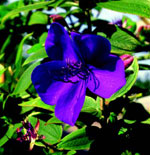Tibouchina: A Regal Shrub That Tolerates Drought
go.ncsu.edu/readext?232793
en Español / em Português
El inglés es el idioma de control de esta página. En la medida en que haya algún conflicto entre la traducción al inglés y la traducción, el inglés prevalece.
Al hacer clic en el enlace de traducción se activa un servicio de traducción gratuito para convertir la página al español. Al igual que con cualquier traducción por Internet, la conversión no es sensible al contexto y puede que no traduzca el texto en su significado original. NC State Extension no garantiza la exactitud del texto traducido. Por favor, tenga en cuenta que algunas aplicaciones y/o servicios pueden no funcionar como se espera cuando se traducen.
Português
Inglês é o idioma de controle desta página. Na medida que haja algum conflito entre o texto original em Inglês e a tradução, o Inglês prevalece.
Ao clicar no link de tradução, um serviço gratuito de tradução será ativado para converter a página para o Português. Como em qualquer tradução pela internet, a conversão não é sensivel ao contexto e pode não ocorrer a tradução para o significado orginal. O serviço de Extensão da Carolina do Norte (NC State Extension) não garante a exatidão do texto traduzido. Por favor, observe que algumas funções ou serviços podem não funcionar como esperado após a tradução.
English
English is the controlling language of this page. To the extent there is any conflict between the English text and the translation, English controls.
Clicking on the translation link activates a free translation service to convert the page to Spanish. As with any Internet translation, the conversion is not context-sensitive and may not translate the text to its original meaning. NC State Extension does not guarantee the accuracy of the translated text. Please note that some applications and/or services may not function as expected when translated.
Collapse ▲
Tibouchina urvilleana
JC Raulston Arboretum ©
Tibouchina urvilleana (tib-oo-KYE-nuh er-vill-ee-AY-nuh) is native to Brazil and is commonly known as princess flower, glory bush, and purple glory bush. The princess flower is a versatile flowering evergreen shrub that can add interest to any landscape. It is ideal for a mixed border that includes shrubs and perennials, and it also works well in groupings of shrubs. Depending on how it is trained, this plant can demonstrate either a mounding shrub or small tree form. When mature, T. urvilleana reaches 10 to 15 feet high and 10 to 12 feet wide. It is fast growing and can be propagated by softwood cuttings and division of clumps.
The princess flower produces brilliant royal-purple flowers from May to January. The 3-inch diameter flowers have a fluorescent quality that is complemented by very attractive foliage. The large coarse leaves are 2 to 4 inches long and 1 to 11/2 inches wide, with three to five major veins along the length of each leaf.
One of T. urvilleana’s unique qualities is that it can display vivid flowering for several months of the year when provided full sun, well-drained soil and regular watering. Another unique quality is its high drought tolerance. Its ability to survive periods of drought, however, comes at the expense of flower production. This shrub is most popular in frost-free areas of the world but will perform well in USDA hardiness zones 8 through 12. In zones that experience seasonal freezing temperatures, the princess flower will die back after a hard frost but return to bloom again in mid- to late-summer.

Tibouchina urvilleana
JC Raulston Arboretum ©
The princess flower could easily become your favorite flowering shrub. An ideal place to use this regal shrub would be near an outdoor living area where the flowers and foliage can easily be seen. Princess flower adds texture and interest to foundation and border plantings with enough color to grab the attention of anyone who passes by. As the popularity of this shrub increases, you may see other Tibouchina species make their way to your local nursery.
Scott Ewers


